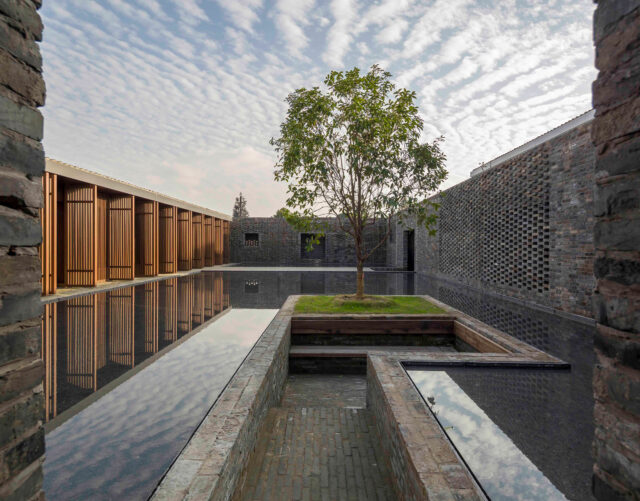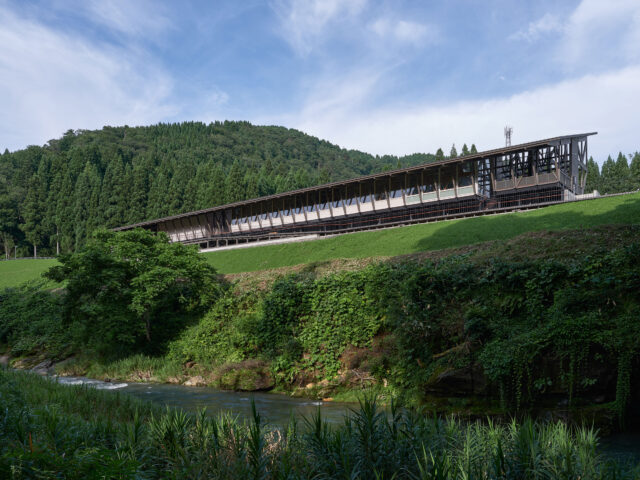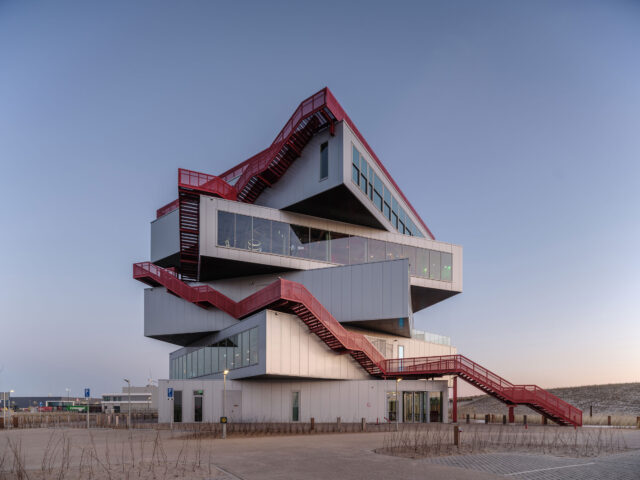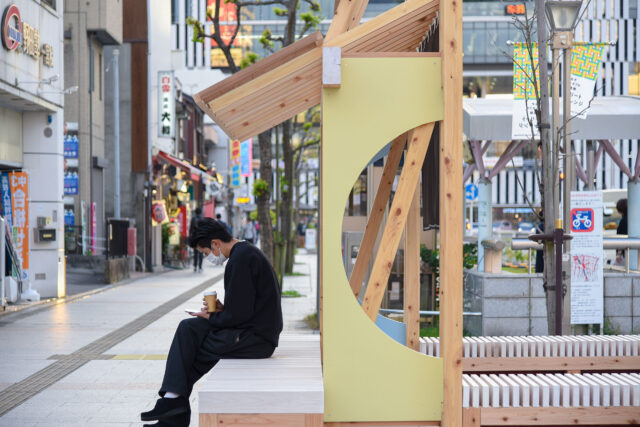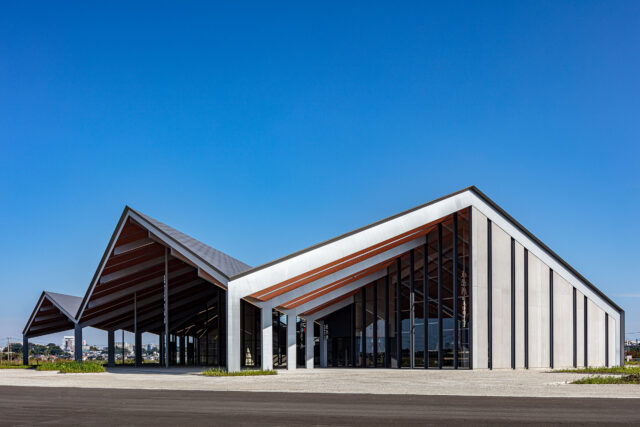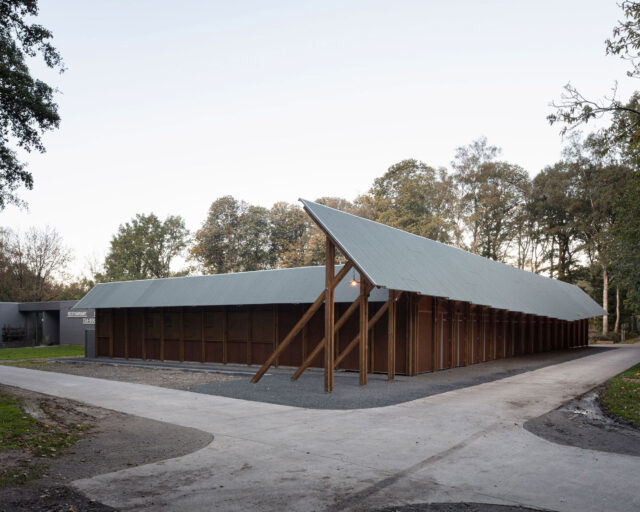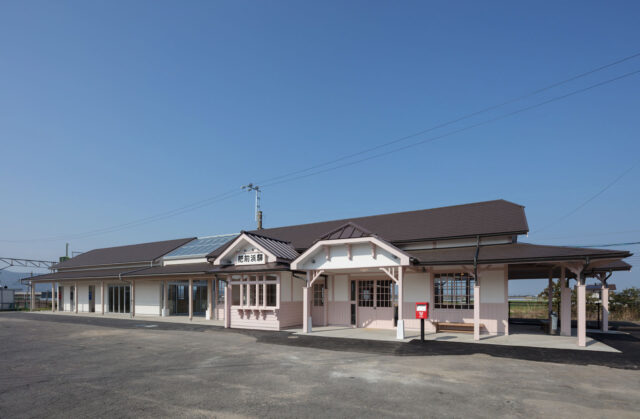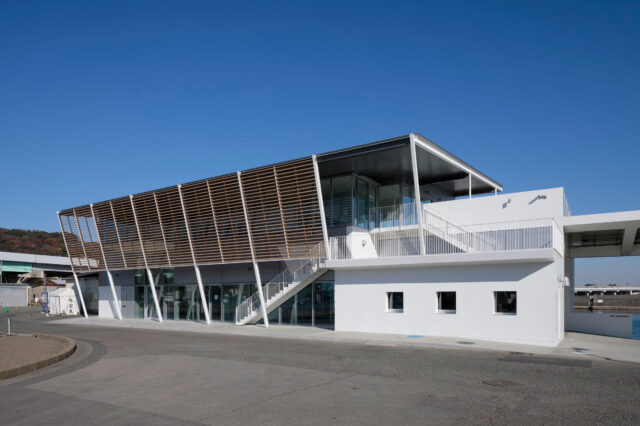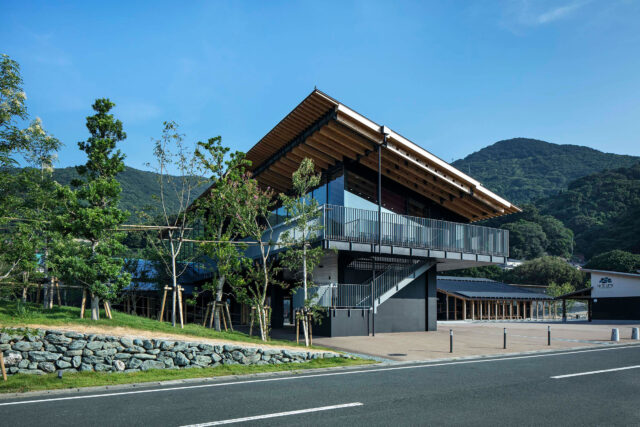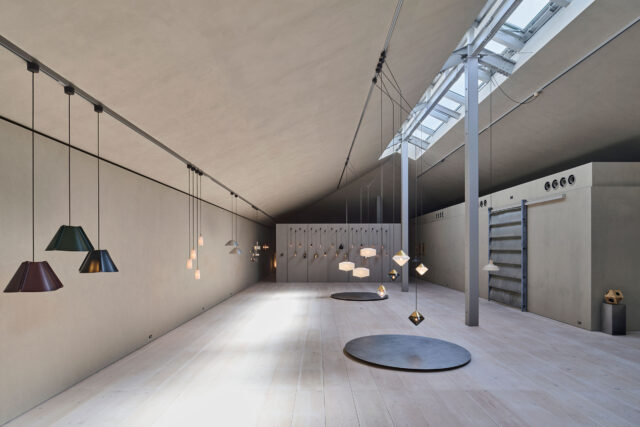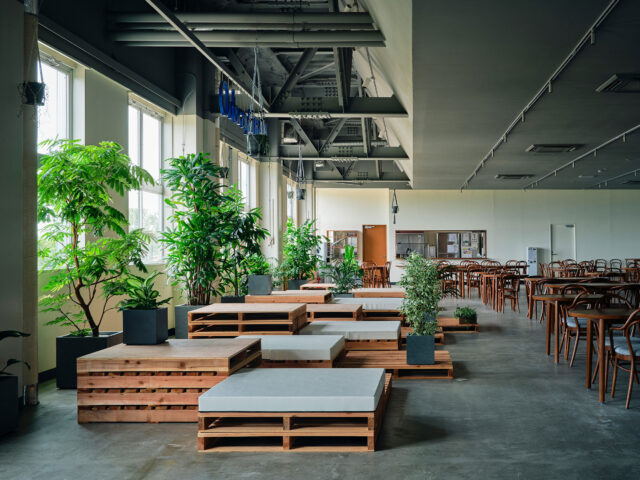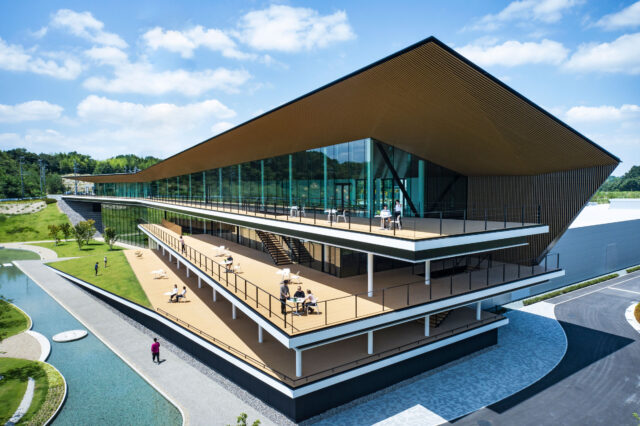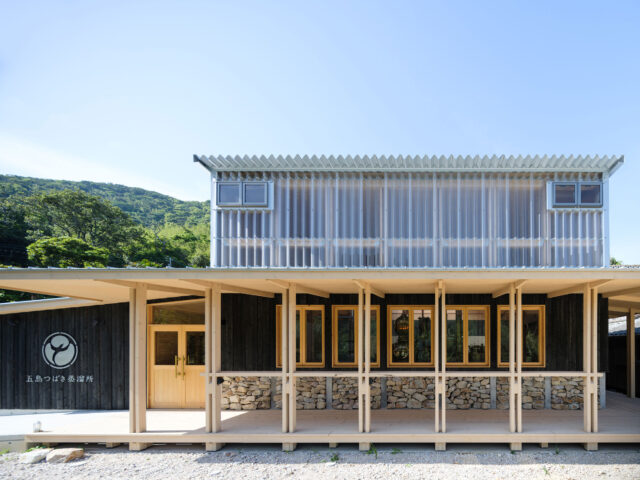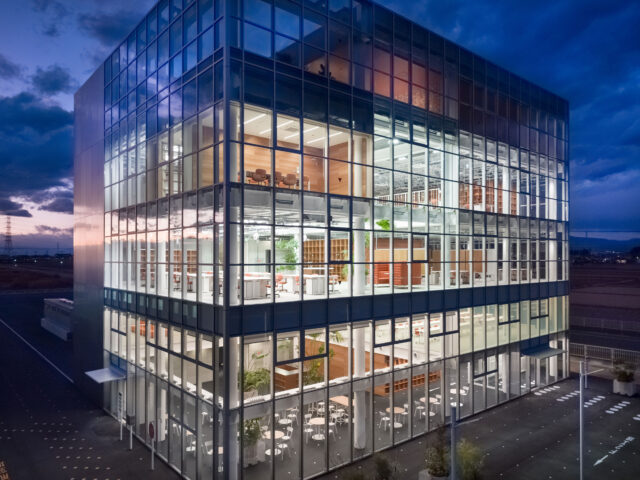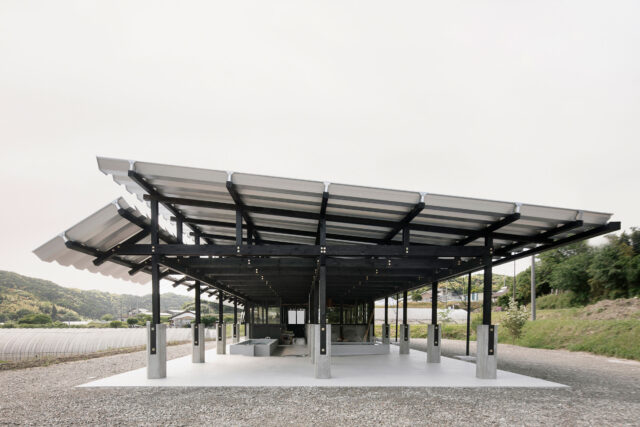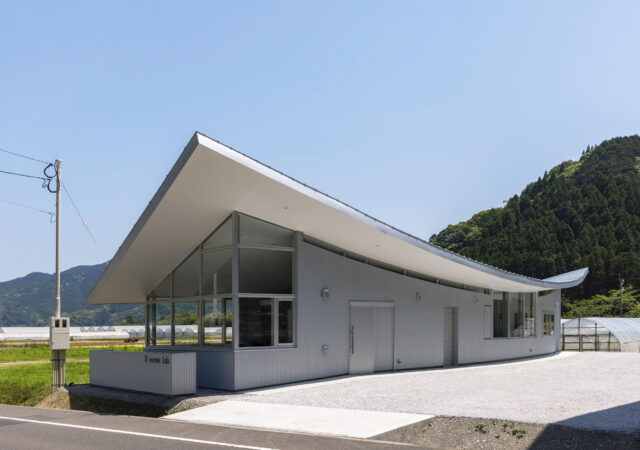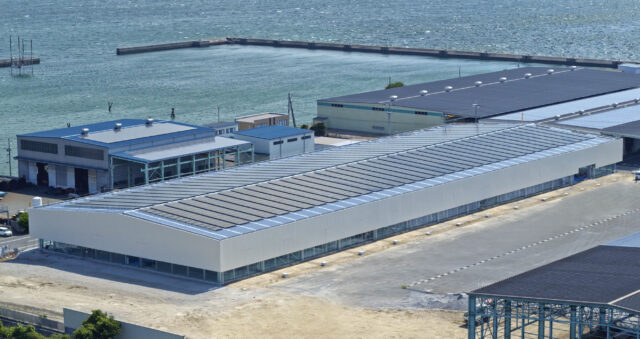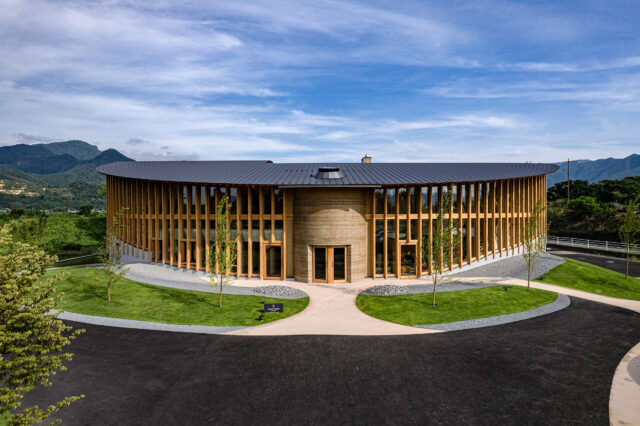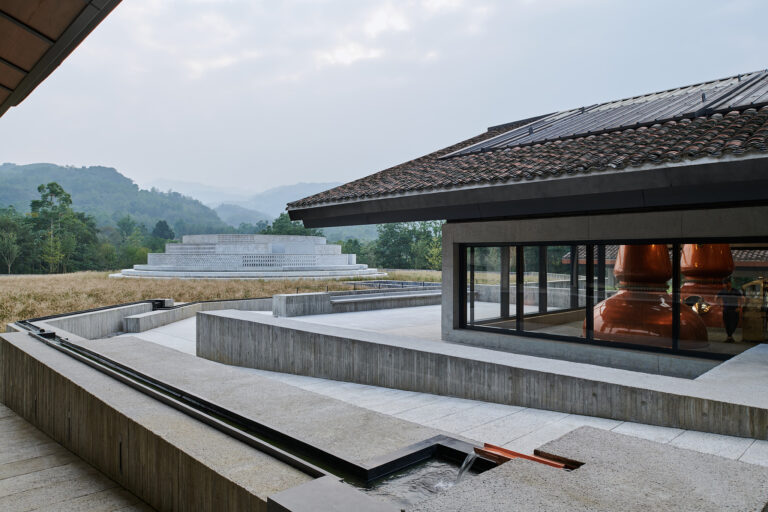
SHARE ネリ&フーによる、中国・峨眉山の「チュアン・モルトウイスキー蒸溜所」。中国で最も精神的に深い場所として知られる敷地に、中国哲学の“山水”の精神に基づき、建築の外観や形態において二面性を持つ建築を構想




ネリ&フーが設計した、中国・峨眉山の「チュアン・モルトウイスキー蒸溜所」。中国で最も精神的に深い場所として知られる敷地に、中国哲学の“山水”の精神に基づき、建築の外観や形態において二面性を持つ建築が構想されました。
こちらは建築家によるテキストの翻訳
Shan-shui: 二面性|チュアン モルト ウイスキー蒸溜所
1,000年以上にわたり峨眉山は、中国で最も精神的に深い場所のひとつとして存続しており、1996年にユネスコの世界遺産に登録されました。何世紀にもわたって、この土地は印象的な修道院、歴史的な戦いの場、多くの巡礼路や貿易路の中継地として使われてきました。今ではその名残はありませんが、その空虚さが記憶を呼び覚ましています。3年前、ネリ&フーはデザインコンペを勝ち抜き、ペルノ・リカールの中国初のウイスキーのための蒸留所と家の設計に挑みました。これは、先見性のある新しいブランドの基本的な価値観や、維持しようとする物質的・文化的な遺産に語りかける、時代を超えた建築を創造する機会となりました。
三方を曲がりくねった小川に囲まれ、雄大な峨眉山を背景にしたこのプロジェクトの敷地は、私たちの住む世界を構成する自然要素の二面性という中国の概念を象徴しています。Shan-shuiは文字通り「山水」を意味します。「山」は力強さや永続性を表し、「水」は流動性や変化を表し、相反するが相互に補完する力を持っています。この哲学の精神に基づいて、この提案の立場は、自然への深い敬意をもって、謙虚さとシンプルさを強みとする身振りを考案することです。このパラダイムは、中国の伝統的な絵画の3つのジャンルの1つである山水画にも現れており、2つの要素を統合することで、絵画の別の次元へと導いています。このバランスのとれた二面性は、建築物自体にも様々な形で現れています。工業用の建物は中国の地方建築を現代的に解釈したものであり、ビジター用の建物は地形に根ざした要素的な幾何学模様です。
敷地の北側には、ウイスキー製造施設を収容する3棟の長い建物があります。これらの建物は、自然の緩やかな斜面に平行に配置され、屋根のラインは徐々に下がっています。現代的なコンクリートの柱と梁で構成された構造体の上に葺かれた屋根には、現地の建築様式を反映して、再生された粘土瓦が質素な風合いを与えています。ロックウォールのインフィルは、敷地を整地する際に地面から取り出された岩石で作られており、破壊と再生のサイクルが永続的な進化を遂げるようになっています。
一方、2つの顧客体験の建物は、中国哲学で天と地を表す「円」と「四角」という基本的な幾何学図形に基づいて建てられています。丸いテイスティング棟は、一部が地中に埋まっており、5つのテイスティングルームがドーム型の中庭を囲むように配置され、中央には滝のような水が流れています。ドームの上部は地面から少しだけ顔を出しており、その上には3つの同心円状のレンガの輪があり、峨眉山のシルエットを微妙に反映しています。この彫刻的な地形は、敷地のどこからでも見られる象徴的な存在となり、また、来訪者が全景を楽しむことができる最高の目的地としての役割を果たしています。四角いレストラン&バーの建物は、地形のさらに下に位置し、2つの面が片持ちになっていて、片方の角は川岸に浮かんでいます。ダイニングスペースは建物の外周に沿って開放的に構成されていますが、中心部にはオープンエアの中庭があり、峨眉山を借景としています。
このプロジェクトは、敷地の自然資源への深い感謝に加えて、中国の伝統的な職人技や素材の知識と対話しながら、ウイスキーの製造とブレンドに込められた洗練された芸術性を具現化したものです。ベースとなる素材は、コンクリート、セメント、石材など様々な種類があり、この土地の強い鉱物の存在と共鳴しています。アクセントとなる素材は、銅製の蒸留ポットや熟成したオーク樽など、ウイスキー作りに使われるものが使われています。ネリ&フーはプロジェクト全体を通して、中国の「相反する2つの要素が互いに補い合う」という概念を体現し、建築とランドスケープ、産業と訪問者の体験、山と水の間に調和のとれたバランスを取ることを目指しています。
以下の写真はクリックで拡大します




















以下、建築家によるテキストです。
Shan-shui: A Duality | The Chuan Malt Whisky Distillery
For over a thousand years Mount Emei has persisted as one of the most deeply spiritual places in China and was named a UNESCO World Heritage Site in 1996. The revered ground upon which our site sits has a rich history itself – through the centuries, this land was once an impressive monastery, the site of several historic battles, and a stopping point along many pilgrimage and trade routes. While any built remnants of the past no longer remain on site, its very emptiness is powerfully suggestive of all of its fabled memories. Three years ago, Neri&Hu won the design competition and took up the challenge of designing a distillery and home for Pernod Ricard’s first whisky in China, an opportunity to create a timeless architecture that speaks to the core values of a visionary new brand as well as the material and cultural heritage it aspires to sustain.
Surrounded on three sides by a winding creek, and with the majestic Emei peak as a backdrop, the site for this project is an exemplification of the Chinese notion of the duality of natural elements which make up the world we live in. Shan-shui literally means ‘mountain-water.’ While shan represents strength and permanence, shui represents fluidity and transformation; they are two opposing yet complementary forces. In the spirit of this philosophy, the position of the proposal is to conceive a gesture whose very strength lies in its humbleness and simplicity, by its profound respect for nature. This paradigm is also manifested in the shan shui painting, one of the three genres of traditional Chinese painting, in which the integration of two elements leads to another dimension of the picturesque. The architecture itself manifests this balanced duality in many ways, with the industrial buildings as a modern interpretation of vernacular Chinese architecture, and the visitor buildings as elemental geometries grounded in the terrain.
Three long buildings housing the whisky production facilities are situated at the north side of the site; parallel in formation, they are tucked into the natural gentle slope of the land with gradually descending rooflines. In an interpretation of vernacular architecture, reclaimed clay tiles give a humble texture to the pitched roofs that rest upon a modern concrete post-and-beam structure. The infill of rock walls is made from the very boulders extracted from the ground during site leveling, so that the cycle of destruction and recreation may continue in permanent evolution.
In contrast to the vernacular roots of the industrial buildings, the two visitor experience buildings are built upon fundamental geometries: the circle and the square, which in Chinese philosophy represent heaven and earth, respectively. The round tasting experience building is partially submerged in the ground, with five subterranean tasting rooms surrounding a domed courtyard that contains a cascading water feature in the middle. The upper part of the dome reveals itself out of the ground slightly; with three concentric brick rings perched atop, it subtly mirrors the silhouette of Mount Emei. This sculptural landform becomes an iconic presence that can be seen from every part of site, and meanwhile, acts as a culminating destination from which visitors can enjoy a full panoramic vista. The square restaurant and bar building is located further down the topography, cantilevered on two sides with one corner hovering over the river bank. While the dining space is organized along the building’s perimeter for open views, at the core an open-air courtyard is oriented to frame the Emei peak as a borrowed scene.
Besides a deep appreciation for the site’s natural resources, the project is also an embodiment of the refined sense of artistry embedded in whisky-making and blending, which is in dialogue with traditional Chinese craftsmanship and knowledge of materials. A variety of concrete, cement, and stone mixtures form the base material palette, finding resonance in the strong mineral presence of the site. Accent materials are drawn from those used in whisky craft, such as the copper distillation pots to the aged oak casks. Throughout the project, Neri&Hu tries to embody the Chinese concept of the dichotomy of two elements that exist in opposition yet complement each other, and to strike a harmonious balance between architecture and landscape, between industry and visitor experience, between mountain and water.
■建築概要
Shan-shui: A Duality
The Chuan Malt Whisky Distillery
───
Location: Emeishan, Sichuan Province
Date: 2021
Client: Pernod Ricard
Gross Area: 7,350sqm
───
Partners-in-charge: Lyndon Neri, Rossana Hu
Associate director-in-charge: Nellie Yang
Associate: Utsav Jain, Siyu Chen
Design team: Feng Wang, Guo Peng, Josh Murphy, Fergus Davis, Alexandra Heijink, Vivian Bao, Yota Takaira, Rosie Tseng, Nicolas Fardet, Yin Sheng, Lili Cheng, July Huang, Luna Hong, Haiou Xin
Photo and video: Chen Hao
───
Architecture design: Neri&Hu Design and Research Office
Interior design: Neri&Hu Design and Research Office
FF&E design: Design Republic
Landscape design: YIYU Design
Experience design: BRC Imagination Arts
Construction (architecture & landscape): Qi’an Group, Suzhou Hezhan
Construction (interior): K&H International
───
Special Features: Industrial production facility, Visitor center, River and mountain views, Masonry walls, Semi-underground tasting rooms, Open-air domed structure, Cantilevered restaurant building, Water features
───
・Architecture – Materials: Exposed concrete structures, Wood-form concrete, Chiseled concrete, Cast-in-place stone + cement walls, Aggregate concrete, Concrete bricks, Glazing, Clay roof tiles, Copper, Black metal, Elm wood, Bamboo composite wood
・Landscape – Materials: Rough stone (extracted from site excavation), Wood-form concrete, Aggregate concrete, Honed black granite
・Interiors – Materials: Cement plaster, Aggregate concrete, Oak, Copper, Raw steel
・Interiors – Decorative Lighting: Custom design, Viabizzuno, Parachilna
・Interiors – Furniture: Custom design, De La Espada, Classicon, Stellar Works, Vitra, Carl Hansen

